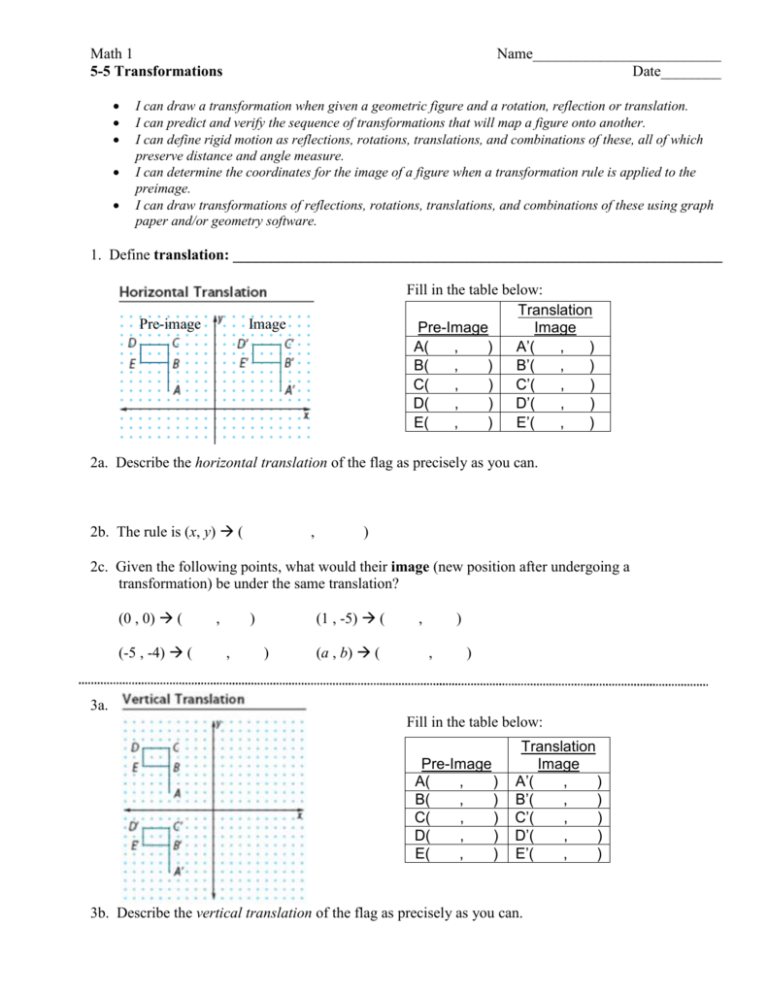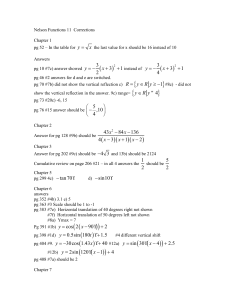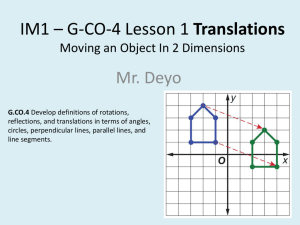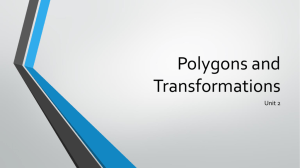5-5 Transformations
advertisement

Math 1 5-5 Transformations Name_________________________ Date________ I can draw a transformation when given a geometric figure and a rotation, reflection or translation. I can predict and verify the sequence of transformations that will map a figure onto another. I can define rigid motion as reflections, rotations, translations, and combinations of these, all of which preserve distance and angle measure. I can determine the coordinates for the image of a figure when a transformation rule is applied to the preimage. I can draw transformations of reflections, rotations, translations, and combinations of these using graph paper and/or geometry software. 1. Define translation: _________________________________________________________________ Pre-image Fill in the table below: Translation Pre-Image Image A( , ) A’( , ) B( , ) B’( , ) C( , ) C’( , ) D( , ) D’( , ) E( , ) E’( , ) Image 2a. Describe the horizontal translation of the flag as precisely as you can. 2b. The rule is (x, y) ( , ) 2c. Given the following points, what would their image (new position after undergoing a transformation) be under the same translation? (0 , 0) ( (-5 , -4) ( , (1 , -5) ( ) , ) (a , b) ( , ) , ) 3a. Fill in the table below: Pre-Image A( , ) B( , ) C( , ) D( , ) E( , ) Translation Image A’( , ) B’( , ) C’( , ) D’( , ) E’( , ) 3b. Describe the vertical translation of the flag as precisely as you can. 3c. The rule is (x, y) ( , ) 3d. Given the following points, what would their image be under the same translation? (0 , 0) ( , (4.1 , -2) ( ) , ) (2 , 5) ( , (a , b) ( , ) ) 4a. Fill in the table below: Pre-Image A( , ) B( , ) C( , ) D( , ) E( , ) Translation Image A’( , ) B’( , ) C’( , ) D’( , ) E’( , ) 4b. Describe the oblique translation of the flag as precisely as you can. 4c. The rule is (x, y) ( , ) 4d. Given the following points, what would their image be under the same translation? (0 , 0) ( (4.1 , -2) ( , (2 , 5) ( ) , ) , (a , b) ( ) , ) In general, when translating a pre-image h units horizontally and k units vertically, the translation rule will be (x, y) ( , ) 5a. Fill in the table below: 90° Counterclockwise Pre-Image Rotation Image A(0, 0) A'( , ) B(3, 3) B'( , ) C(5, 5) C'( , ) D(7, 3) D'( , ) E(5, 1) E'( , ) 5b. The rule for a 90° rotation is (x, y) ( , ) 5c. Notice the angles that were formed through this rotation. For example, look at the measures of COC ' and EOE ' . How are the two angles related? 5d. The slope of the line through a pre-image point and the origin should be the ___________________ 6a. _________________________ of the slope of a line through the image point and the origin. Fill in the table below: 180° Counterclockwise Pre-Image Rotation Image A(0, 0) A'( , ) B(3, 3) B'( , ) C(5, 5) C'( , ) D(7, 3) D'( , ) E(5, 1) E'( , ) 6b. The rule for a 180° rotation is (x, y) ( , ) 6c. Notice the angles that were formed through this rotation. For example, look at the measures of COC ' and EOE ' . How are the two angles related? 7a. Fill in the table below: 270° Counterclockwise Pre-Image Rotation Image A(0, 0) A'( , ) B(3, 3) B'( , ) C(5, 5) C'( , ) D(7, 3) D'( , ) E(5, 1) E'( , ) 7b. The rule for a 270° rotation is (x, y) ( , ) 7c. Notice the angles that were formed through this rotation. For example, look at the measures of COC ' and EOE ' . How are the two angles related? 8a. Fill in the table below: Reflection Image over y-axis Pre-Image A(-5, 2) B(-5, 5) C(-5, 7) D(-8, 7) E(-8, 5) A'( B'( C'( D'( E'( , , , , , ) ) ) ) ) 8b. Describe the y-axis reflection of the flag as precisely as you can. 8c. The rule for a y-axis reflection is (x, y) ( , ) 9. Reflected Across the x – axis Read #9a below then fill in the table: Pre-Image Reflection Points over x-axis A(-4, 1) B(3, -2) C(-2, -5) D(4, 5) E(0, 1) F(-3, 0) A'( B'( C'( D'( E'( F'( , , , , , , ) ) ) ) ) ) 9a. Reflect the above points over the x-axis on the graph. Label your points and write the coordinates in the table. Draw a dotted line connecting the pre-image points to the reflection points. 9b. What changed about the x-coordinates? The y-coordinates? 9c. Compare the x-axis to the line segments connecting your points. What does the x-axis act as? 9d. The rule for a x-axis reflection is (x, y) ( , ) 10. Reflected over the line y = x Read #10a below then fill in the table: Reflection Points over y = x Pre-Image A(-4, 1) B(3, -2) C(-2, -5) D(4, 5) E(0, 1) F(-3, 0) A'( B'( C'( D'( E'( F'( , , , , , , ) ) ) ) ) ) 10a. Reflect the above points over the line y = x. Label your points and write the coordinates in the table. Draw a dotted line connecting the pre-image points to the reflection points. 10b. What changed about the coordinates? 10c. Compare the line y = x to the line segments connecting your points. What does y = x act as? 10d. The rule for a reflection over y = x is (x, y) ( , ) 11. Reflected over the line y = -x Read #11a below then fill in the table: Reflection Points over y = -x Pre-Image A(-4, 1) B(3, -2) C(-2, -5) D(4, 5) E(0, 1) F(-3, 0) A'( B'( C'( D'( E'( F'( , , , , , , ) ) ) ) ) ) 11a. Reflect the above points over the line y = -x. Label your points and write the coordinates in the table. Draw a dotted line connecting the pre-image points to the reflection points. 11b. What changed about the coordinates? Be specific! 11c. Compare the line y = -x to the lines connecting your points. What does y = -x act as? 11d. The rule for a reflection over y = -x is (x, y) ( , ) 12. Reflect the following figure over the line x = -2. 13. Reflect the following figure over the line y = -2. 14. Triangle ABC has vertices at A(-1, 2), B(3, 4), and C(6, 0) in the coordinate plane. The triangle will be reflected over the y-axis and then shifted 5 units left and 2 units down. What are the new coordinates of A ' B ' C '?




